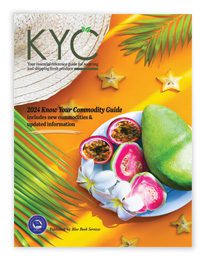Golden Berry Market Summary


Image: mircea dobre/Shutterstock.com
Golden Berry Market Overview
Golden berries, frequently spelled as one word, are commonly called Cape gooseberries, Chinese lanterns, physalis, husk cherries, ground cherries, Aztec or Incan berries, as well as a plethora of local and indigenous names like poha in Hawaii, aguaymant in Peru, and uchuva in Colombia. In a nod to their ancestry, another name is Pichuberry, referring to Machu Picchu in southern Peru. To bring attention to the berries and encourage U.S. production, the American Pichuberry Association was formed and “Pichuberry” trademarked for members-only use. Endemic to South America and the Andes mountains, there is disagreement on where the berries originated: Brazil or Peru, though their Latin name is Physalis peruviana. The berries were first mentioned in England in the 1700s, then found their way to South Africa. Many attribute the Cape gooseberry name to the Cape of Good Hope, but others say it is due to the husk, which resembles a cape. The berries arrived in Hawaii in 1825 where they continue to be cultivated on the Big Island. Explorers also carried the fruit to ports throughout Australia, Oceania, and Asia, often as a remedy for scurvy. Golden berries are cultivated in South Africa, Australia, New Zealand, and India, as well as Central and South America. South America is the world’s primary supplier, with both Ecuador and Colombia producing the fruit year-round. Colombia continues gaining ground as a leader in both acreage and export tonnage. This petite superfruit belongs to the nightshade family (Solanaceae) like eggplant, potatoes, and tomatoes. Physically, golden berries resemble tomatillos, which also have a papery, protective husk. Characterized by their piquant sweet and tart (acidic) taste, the berries can be eaten fresh or cooked; however, flowers, leaves, and unripe fruit are toxic and should not be consumed.
Types & Varieties of Golden Berries
Golden berries are herbaceous shrubs that typically reach heights of 2 to 3 feet and feature yellow and purple flowers. As their name implies, they produce bright yellow or slightly orangish fruit up to an inch in diameter, encased by a strawcolored calyx when fully mature. Two species of golden berry exist—Physalis peruviana and Physalis grisea. The former grows upright and features citrus-flavored fruit; the latter is a sprawling surface plant and produces fruit that tastes like a combination of pineapple and melons. Cultivars include Golden Nugget, New Sugar Giant, Giallo Grosso, Giant Poha Berry, Golden Nugget, Little Lanterns, Long Aston, Dixon, Garrison’s Pineapple Flavor, New Zealand, Peace, and Yellow Improved.

Cultivation of Golden Berries
The golden berry can be grown as an annual or perennial depending on climate, and from seeds/plugs or cuttings. Although plants crave full, direct sunlight, they tolerate shade and cooler temperatures. They will also survive winter temperatures, though freezes will cause harm. When cultivated as an annual, planters should wait until the potential for frost passes. Seedlings are also vulnerable to the opposite extreme, high temperatures, so planting during the late afternoon or overcast weather is recommended. Seedlings should also have ample moisture and shade in sunnier climates until set. When too little water is available, plants will go dormant. Shrubs should be in raised rows with trellises or stakes. Plants perform best in sandy to gravelly loam but any well-drained soil with organic matter will suffice. Plants will begin to bear fruit in 100 to 120 days and produce a copious amount of berries—at lower elevations, irrigated plants can produce more than 1,000 small berries per shrub; higher altitude unirrigated plants bear about 300 larger fruits per individual shrub. During harvest, golden berries can be gathered every few days to weeks apart, but not until the calyxes dry and morph from green to a yellow coloration. Peak production in South America tends to be in October and February. Golden berries are often harvested by hand to avoid bruising, though many producers shake the shrubs to detach the husks, sometimes covering the ground in plastic sheets for collection.
Pests & Diseases Affecting Golden Berries
Golden berries are susceptible to a number of pests including beetles, caterpillars, treehoppers, thrips, hornworms, cutworms, red spiders, whiteflies, and many varieties of moth—all of which deform leaves and defoliate plants. Broad mites puncture plant stems and consume sap, disfiguring and discoloring leaves and inhibiting development, while if shrubs are adjacent to potato fields, potato tuber moths can migrate and affect growth. Other concerns include powdery mildew, scale, nematodes, bacterial leaf spot, mosaic virus, sooty mold, and bacterial wilt. Proper drainage, field sanitation, and biennial plantings can help mitigate the damage and prevent infecting subsequent crops.Storage & Packaging of Golden Berries
Optimal storage temperature is 46°F. Golden berries will maintain their freshness longer while enclosed in the calyx (approximately 60 days) than outside it (up to 30 or so days). Commercial producers freeze berries within the calyx at 33°F, which can preserve them for up to a year. References: California Rare Fruit Growers, Inc., NC Cooperative Extension, Purdue University, Rutgers University, University of Arkansas Extension, University of Maryland Extension, University of Hawaii, USDA.Grades & Good Arrival of Golden Berries
Currently, there are no existing grades or guidelines for golden berries.Golden Berry/Cape Gooseberry Terminal Market Pricing: Cartons



